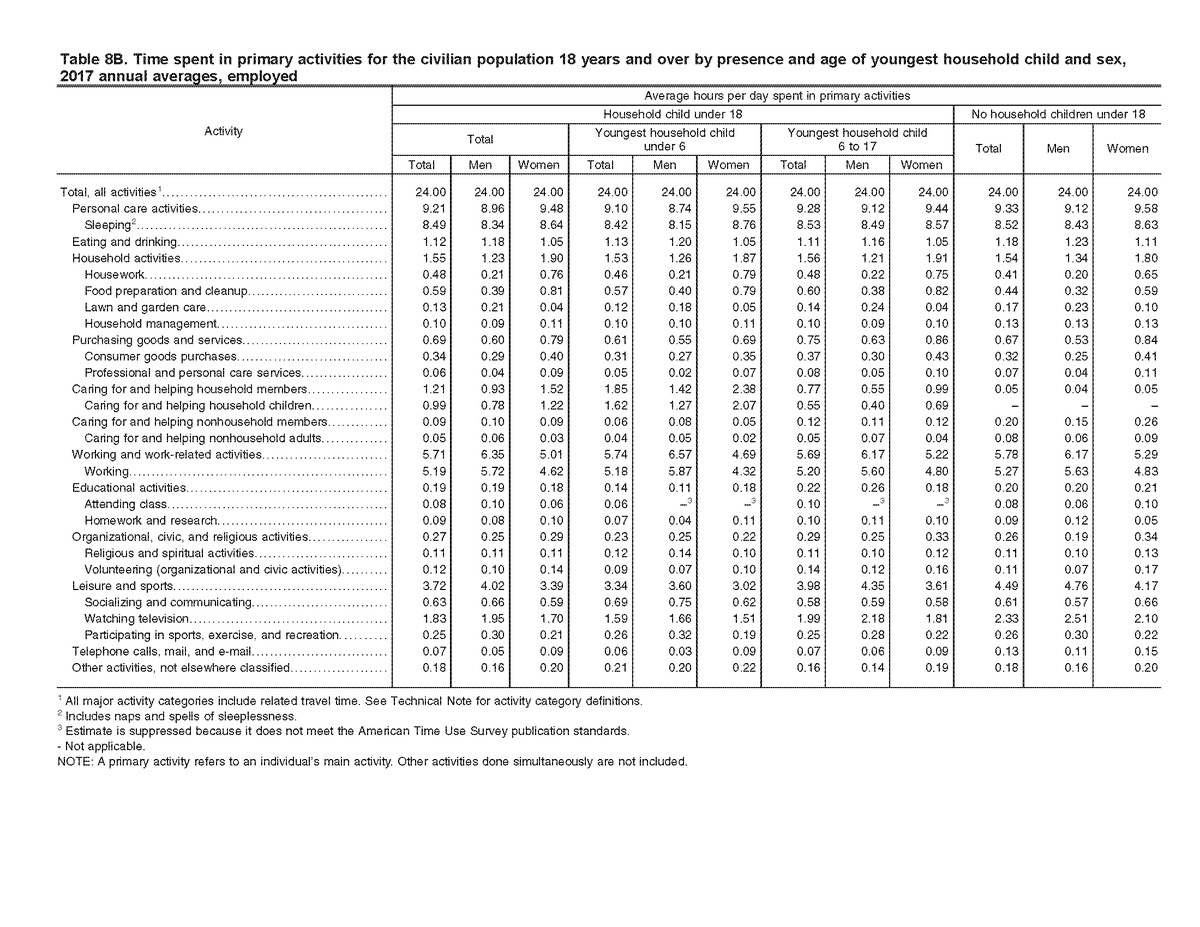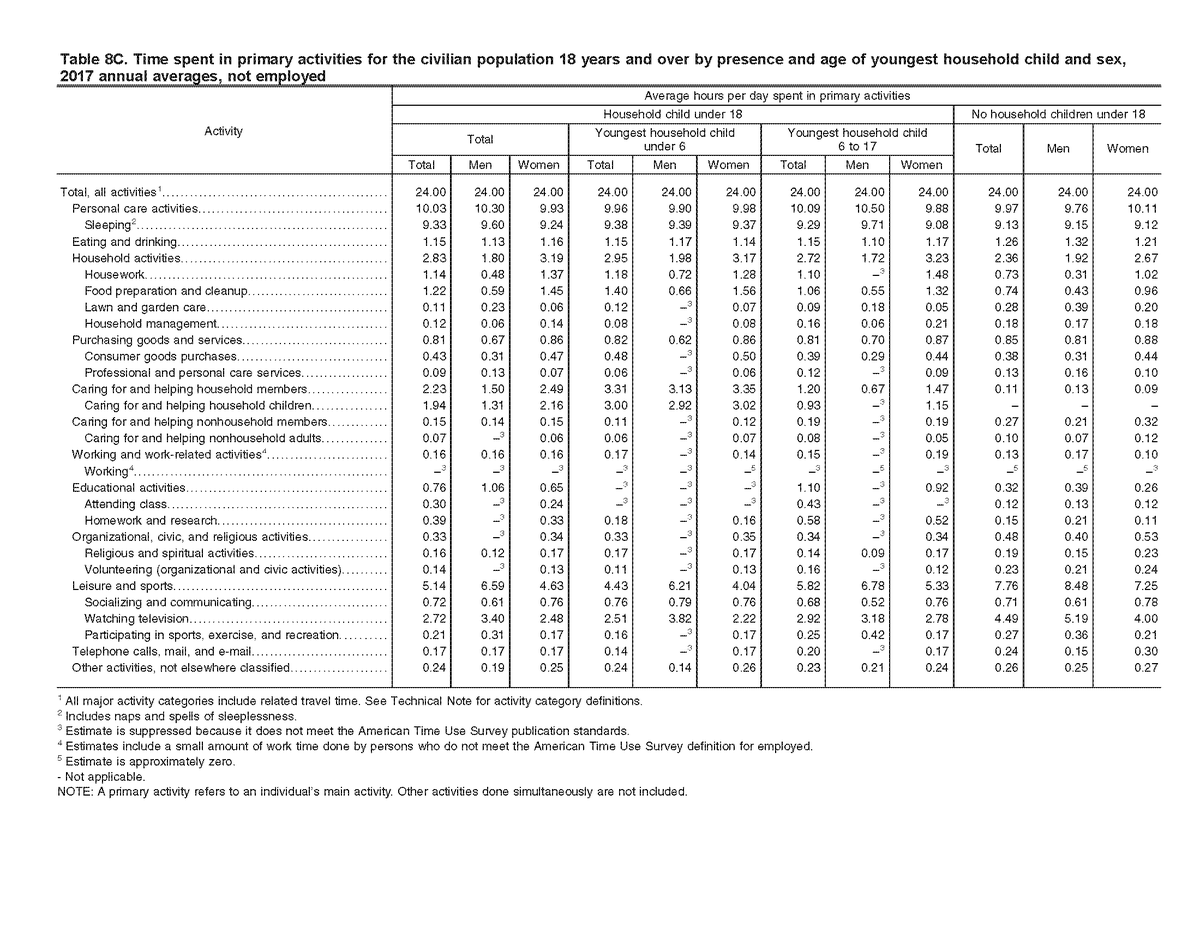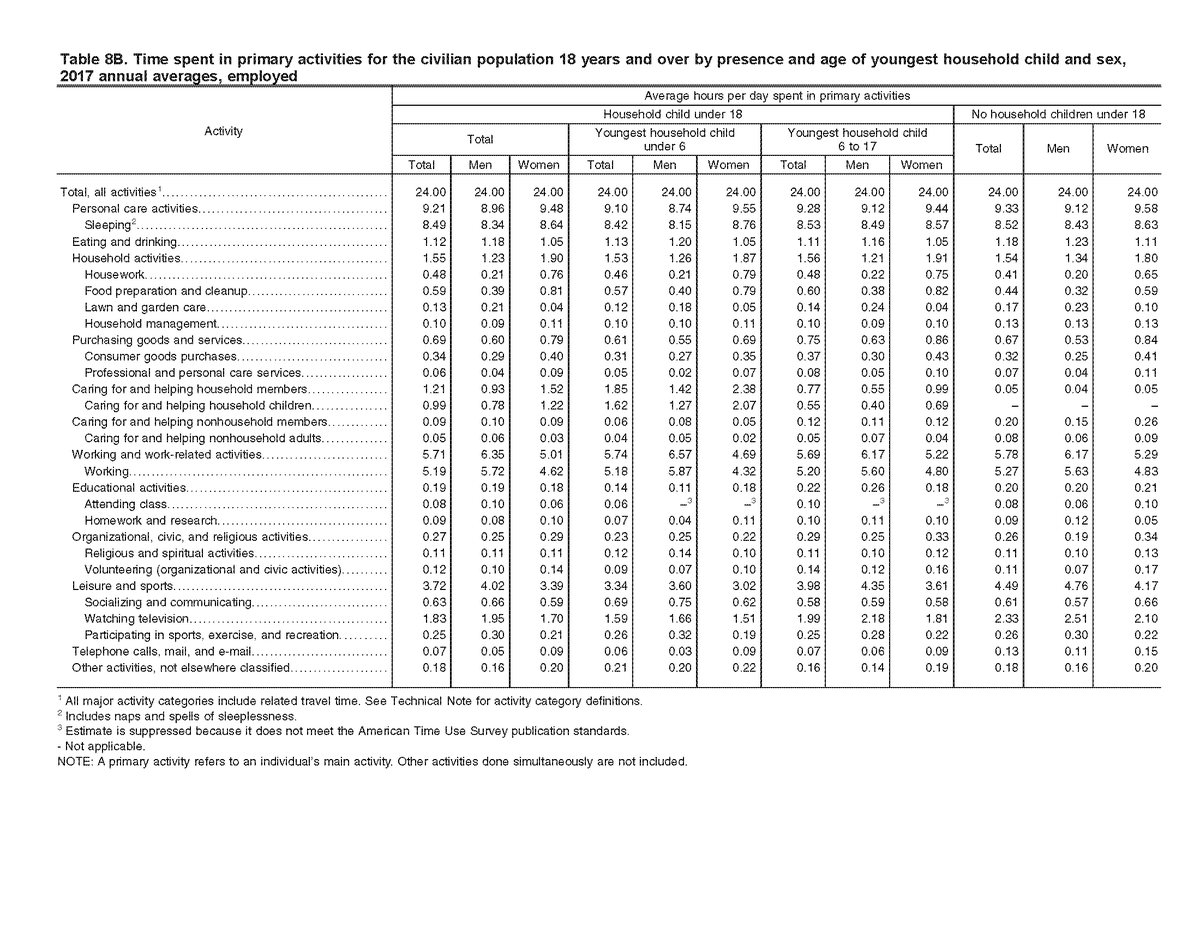
@Alexand59482200 Women have to be willing to do equal work. Statistically, most women do not do equal work. This must change if there is to be the equality of which you speak.
Let's look at the data!
Let's look at the data!
@Alexand59482200 If you add up both the unpaid labor and paid labor, on average, men work more total time than women creating a #GenderedLaborGap pursuant to (as an example) the @BLS_gov's 2017 American Time Use Survey (bls.gov/news.release/a…) and @pewresearch's data (pewresearch.org/fact-tank/2018…). 







@Alexand59482200 @BLS_gov @pewresearch According to the @BLS_gov, "[o]n the days they worked, employed men worked 49 minutes more than employed women. … However, even among full-time workers (those usually working 35 hours or more per week), men worked more per day than women—8.4 hours, compared with 7.9 hours."
@Alexand59482200 @BLS_gov @pewresearch Pursuant to @BLS_gov data in the American Time Use Survey, the average man is getting the equivalent of over 26½ (8-hour) days of experience more than the average woman is getting on the job (bls.gov/news.release/a…, p. 2).
@Alexand59482200 @BLS_gov @pewresearch Dividing the total hours worked into 8-hour workdays, using the @BLS_gov data from the American Time Use Survey, it's as if men (on average) are working nearly 13 months a year to women's less than 12 months per year (bls.gov/news.release/a…, p. 2).
@Alexand59482200 @BLS_gov @pewresearch Now, looking only at full-time workers, pursuant to @BLS_gov data in the American Time Use Survey, the average man is getting the equivalent of over 16 (8-hour) days of experience more than the average woman is getting on the job (bls.gov/news.release/a…, p. 2).
@Alexand59482200 @BLS_gov @pewresearch Dividing the total hours worked into 8-hour workdays, using the @BLS_gov data from the American Time Use Survey, it's almost as if men (on average) are working nearly 12½ months a year to women's less than 12 (bls.gov/news.release/a…, p. 2).
Albeit slower, this adds up fast.
Albeit slower, this adds up fast.
@Alexand59482200 @BLS_gov @pewresearch American Time Use Survey (with 2017 as an example) shows that women on average are not spending enough more time with their kids, doing chores, or anything else to explain women's lack of time working.
On average, men just work more in America (considering both paid and unpaid).
On average, men just work more in America (considering both paid and unpaid).

@Alexand59482200 @BLS_gov @pewresearch Let's do the math:
Table 8A, column 1: Men: Women:
Household activities: 1.31 2.34
Caring for household: 1.01 1.85
Work-related activities: 5.46 3.37
==========
Total: 7.78 7.56
Table 8A, column 1: Men: Women:
Household activities: 1.31 2.34
Caring for household: 1.01 1.85
Work-related activities: 5.46 3.37
==========
Total: 7.78 7.56

@Alexand59482200 @BLS_gov @pewresearch Now comparing the men from Table 8B to the women from Table 8C (where the youngest child is under 6):
Women care for and help household members 2.08 more hours per day than men in the most extreme case presented by Table 8A, but men work 6.43 hours more per day than women.

Women care for and help household members 2.08 more hours per day than men in the most extreme case presented by Table 8A, but men work 6.43 hours more per day than women.


@Alexand59482200 @BLS_gov @pewresearch Similarly, comparing the men from Table 8B to the women from Table 8C (where the youngest child is under 6), women do household activities for 1.91 more hours per day than men in the most extreme case presented by Table 8A, but, again, men work 6.43 hours more per day than women. 



@Alexand59482200 @BLS_gov @pewresearch Let's do the math: Men: Women:
Household activities: 1.26 3.17
Caring for household: 1.42 3.36
Work-related activities: 6.57 0.00
==========
Total: 9.25 6.53
Who is doing more?

Household activities: 1.26 3.17
Caring for household: 1.42 3.36
Work-related activities: 6.57 0.00
==========
Total: 9.25 6.53
Who is doing more?


@Alexand59482200 @BLS_gov @pewresearch By comparing the men from Table 8B to the women from Table 8C (using the youngest child under 6 column), we see the situation where women are unemployed and spending the most time caring not only for the children but the whole family. 



@Alexand59482200 @BLS_gov @pewresearch If women with kids are working fewer paid work hours due to the number of hours spent on childcare responsibilities, we should've seen women performing as many domestic labor hours as men were spending doing paid labor, but that isn't what we see.
We only see women working less.
We only see women working less.
@Alexand59482200 @BLS_gov @pewresearch Other @BLS_gov data (see below) indicates that 61% of families have both parents employed (bls.gov/opub/ted/2017/…), but does not indicate whether the mothers are working full-time or part-time.
The American Time Use Survey does have an answer in Table 8B.
Let's check that out.
The American Time Use Survey does have an answer in Table 8B.
Let's check that out.

@Alexand59482200 @BLS_gov @pewresearch Maybe women are forced to stay home with their kids and that causes the gap. If true, women with no kids should be working the same amount as men in the workforce as there is no reason not to since there is no reason to be on call and no extra household or child care duties.
@Alexand59482200 @BLS_gov @pewresearch Let's do that math:
Table 8A, column 4: Men: Women:
Household activities: 1.54 2.21
Caring for household: 0.07 0.07
Work-related activities: 4.11 2.83
===========
Total: 5.72 5.11
Table 8A, column 4: Men: Women:
Household activities: 1.54 2.21
Caring for household: 0.07 0.07
Work-related activities: 4.11 2.83
===========
Total: 5.72 5.11

@Alexand59482200 @BLS_gov @pewresearch Consider just workers:
Table 8B, column 4: Men: Women:
Household activities: 1.34 1.80
Caring for household: 0.04 0.05
Work-related activities: 6.17 5.29
===========
Total: 7.55 7.14
Table 8B, column 4: Men: Women:
Household activities: 1.34 1.80
Caring for household: 0.04 0.05
Work-related activities: 6.17 5.29
===========
Total: 7.55 7.14

@Alexand59482200 @BLS_gov @pewresearch Whether you consider all currently childless folks (Table 8A) or just the ones working (Table 8B), women spend less time on paid labor and related activities and women spend less time working considering both unpaid domestic labor and paid labor added together. The pattern holds. 



@Alexand59482200 @BLS_gov @pewresearch Moreover, homemaking is not usually physically demanding work (unlike the paid labor many men do that women typically do not).
See, Women Workers and Women at Home Are Equally Inactive: NHANES 2003–2006 (available at ncbi.nlm.nih.gov/pmc/articles/P…).
See, Women Workers and Women at Home Are Equally Inactive: NHANES 2003–2006 (available at ncbi.nlm.nih.gov/pmc/articles/P…).
@Alexand59482200 @BLS_gov @pewresearch "Women spent most of their day in sedentary (~55%) and light (~32%) activity, with limited lifestyle (~11%) and moderate vigorous physical activity (MVPA) (~2%), and there were no differences between the homemakers and [employed women]" (ncbi.nlm.nih.gov/pmc/articles/P…).
@Alexand59482200 @BLS_gov @pewresearch "Based on self-report, previous studies suggest that homemakers obtain less total physical activity, have lower overall activity-related energy expenditure, and are less likely to participate in vigorous leisure-time physical activity, than [employed women]" (Id.).
@Alexand59482200 @BLS_gov @pewresearch "A recent study conducted by the PEW Research Center found that stay-at-home mothers reported spending more time on childcare, housework, leisure activities, and sleep more than working mothers" (ncbi.nlm.nih.gov/pmc/articles/P…).
@Alexand59482200 @BLS_gov @pewresearch "[O]nce we control only for one variable—hours worked—and compare men and women both working 40-hours per week in 2017, more than one-third of the raw 18.2% pay gap reported by the BLS disappears" (fee.org/articles/a-new…). 

@Alexand59482200 @BLS_gov @pewresearch Did you know that “unmarried, childless women under 30 who live in cities” already out-earn men pursuant to @TIME Magazine (content.time.com/time/business/…), @usnews & World Report (usnews.com/debate-club/sh…), and @PolitiFact's @PunditFact (politifact.com/punditfact/sta…)? 

@Alexand59482200 @BLS_gov @pewresearch @TIME @usnews @PolitiFact @PunditFact "What’s especially interesting is that women working 35-39 hours per week [in 2017] earned 107% of men’s earnings for those weekly hours, i.e., there was a 7% gender earnings gap in favor of female workers for that cohort" (fee.org/articles/a-new…).
@Alexand59482200 @BLS_gov @pewresearch @TIME @usnews @PolitiFact @PunditFact Women being less productive than men (and that contributing to the pay gap) is apparently not news.
@LexyTopping writes "[m]en should work less and their employers and the government should help them to do so in order to close the gender pay gap" (theguardian.com/world/2018/may…).
@LexyTopping writes "[m]en should work less and their employers and the government should help them to do so in order to close the gender pay gap" (theguardian.com/world/2018/may…).
@Alexand59482200 @BLS_gov @pewresearch @TIME @usnews @PolitiFact @PunditFact @LexyTopping On page 5 of _The State of Pay: Demystifying the Gender Pay Gap_ (May 2018), Institute for Public Policy Research writes as part of their 3rd recommendation that "[c]hanging men’s working behaviour is a crucial component of closing the gender pay gap" (ippr.org/files/2018-05/…).
@Alexand59482200 @BLS_gov @pewresearch @TIME @usnews @PolitiFact @PunditFact @LexyTopping "To reduce the gender stratification of full and part-time roles, and reduce the maternity penalty, employers could… introduce dedicated, paid paternity leave…, to advertise roles as flexible by default, and to encourage men to partake in job share arrangements." Id., p. 5.
@Alexand59482200 @BLS_gov @pewresearch @TIME @usnews @PolitiFact @PunditFact @LexyTopping The @IPPR continues stating that the pay gap "doesn’t take into account any of the drivers of different pay levels, such as age, qualifications, experience or seniority, or type of work" (ippr.org/files/2018-05/…, p. 6).
@Alexand59482200 @BLS_gov @pewresearch @TIME @usnews @PolitiFact @PunditFact @LexyTopping @IPPR "As such, a firm-level gender pay gap does not indicate discriminatory practices, and is not unlawful" (ippr.org/files/2018-05/…, p. 6).
The #GenderedLaborGap has real consequences including the so-called #GenderPayGap. Until women work more, these problems will not be fixed.
The #GenderedLaborGap has real consequences including the so-called #GenderPayGap. Until women work more, these problems will not be fixed.
@Alexand59482200 @BLS_gov @pewresearch @TIME @usnews @PolitiFact @PunditFact @LexyTopping @IPPR @threadreaderapp, please unroll.
• • •
Missing some Tweet in this thread? You can try to
force a refresh








